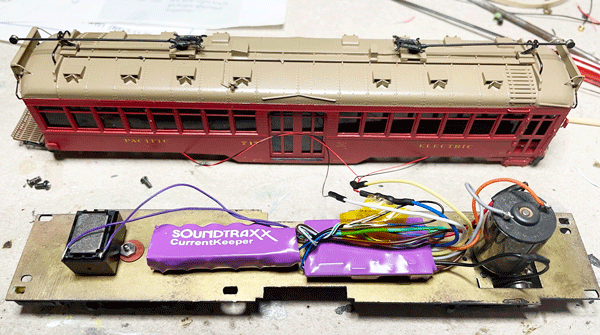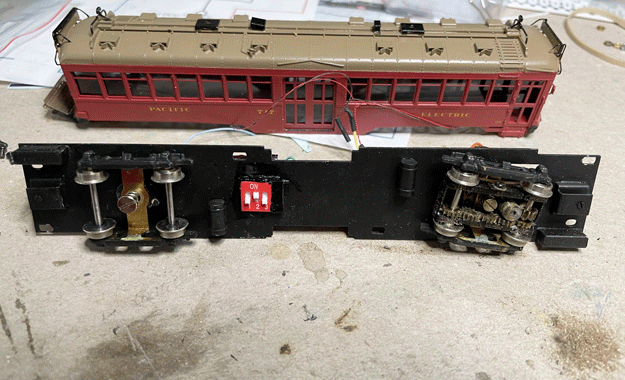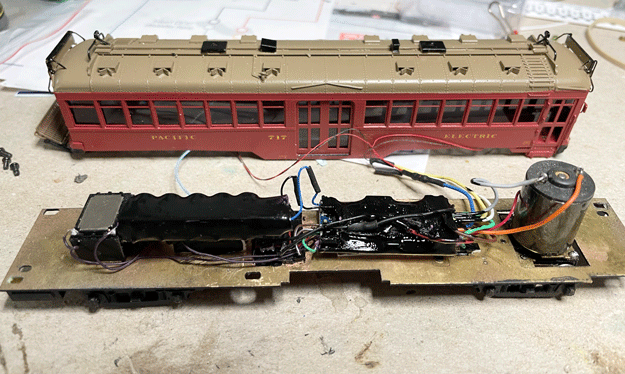Working around a person that does DCC installs on a daily basis forces one to watch and learn. New products come and change the way things are done.
After installing headlights in brass and plastic streetcars for over thirty years, going all the way back to 12v bulbs and migrating through 1.5v bulbs to LEDs, a new product has emerged that changed the game. This is the case with Athearn Genesis HO scale LED bulbs, ATHG67143 and ATHG67145.
Both of these LED bulb assemblies are equipped with clear lenses that are either 6.35 mm (ATHG67145, see above left) or 3.00 mm long (ATHG67143, see above right). But both of them are 1.4 mm in diameter. So the modeler need only drill a hole in the precise center of the headlight opening using a #53 drill, paint the reflector silver. Allow it to dry and and install the HO LED lens from the rear. The rounded ends simulate the incandescent light bulbs used during that era. For most HO scale brass, injection molded plastic and 3D printed shells, the ATHG67143 should do the job.
Note: For those of you who need a smaller LED, Athearn also provides an LED, also in packages of 12, without the lens that is also available in packages of 12, part ATHG67144.
Place a very small amount of Microscale MicroKlear or Canopy Glue on the side of the lens before inserting to hold the entire assembly firmly in place, gently push into the shell from behind and you are done.
Kevin Honda, Manager of Arnie's Model Trains, Westminster, CA, installed headlights in this brass Suydam Hollywood using this method and the results speak for themselves. The incandescent light bulb is clearly seen when the headlight is out but the effect can be detected even when the light is illuminated.
Note: For the record, this car was painted and the decoder installed by Kevin Honda but was not intended to run on overhead wire, so the decoder and speaker were installed on the chassis floor.
Normal Custom Traxx procedure when lights are mounted on the car is to affix the decoder to the underside of the roof, preferably in the center of the car between the trolley pole bases. This minimizes the number of wires from the chassis to the shell which is useful when working on the car. Custom Traxx also installs the three position Dipswitch, accessible from the bottom of the car that permits both 2-rail and overhead wire operation and will do so on this car before releasing it for module operation.
Another advantage of using the Athearn LEDs are the wires that can easily be kept out of sight. With the Tsunami TSU-2200 Electric Sound decoder, Current Keeper and Speaker all mounted on the floor, coupled with the small vertical can motor shown in the next photo, this is a very neat installation. No wires can be seen inside the car in any of the previous photos.
 |
Because we will be operating this car on the SCTC modules, it had to be converted to overhead wire operation. But because the car had the components for DCC/Sound already installed, we would have to make some changes to accommodate the 3-position "Volkmar" Dipswitch, that would permit both two-rail and overhead wire operation. We removed both the Soundtraxx TSU-2200 decoder and the Soundtraxx 810140 Current Keeper which were both installed with double sided tape and cut the required 9.9mm (H) by 9.3mm (W) opening in the brass floor. Because this floor is from an older brass models and is 1mm thick, this is not an easy job and could be a subject of a lesson all in itself. You can see some of the brass shavings in the lower right corner of one of the below photos. Anyway, after the strategic use of some black paint, the results, before final re-assembly are below:
 |
 |
A sharp eyed reader may notice no trolley poles on the car body. This is because the original poles that came with the car are secured to the roof with a nut, which is against the SCTC rules for trolley poles. All trolley poles used on SCTC modules have to be easily removable for maintenance and cleaning. A pair of Miniatures by Eric HT-P4 trolley poles were substituted after receiving a coat of black paint and electrically attached to the blue wire seen in the preceding photo.